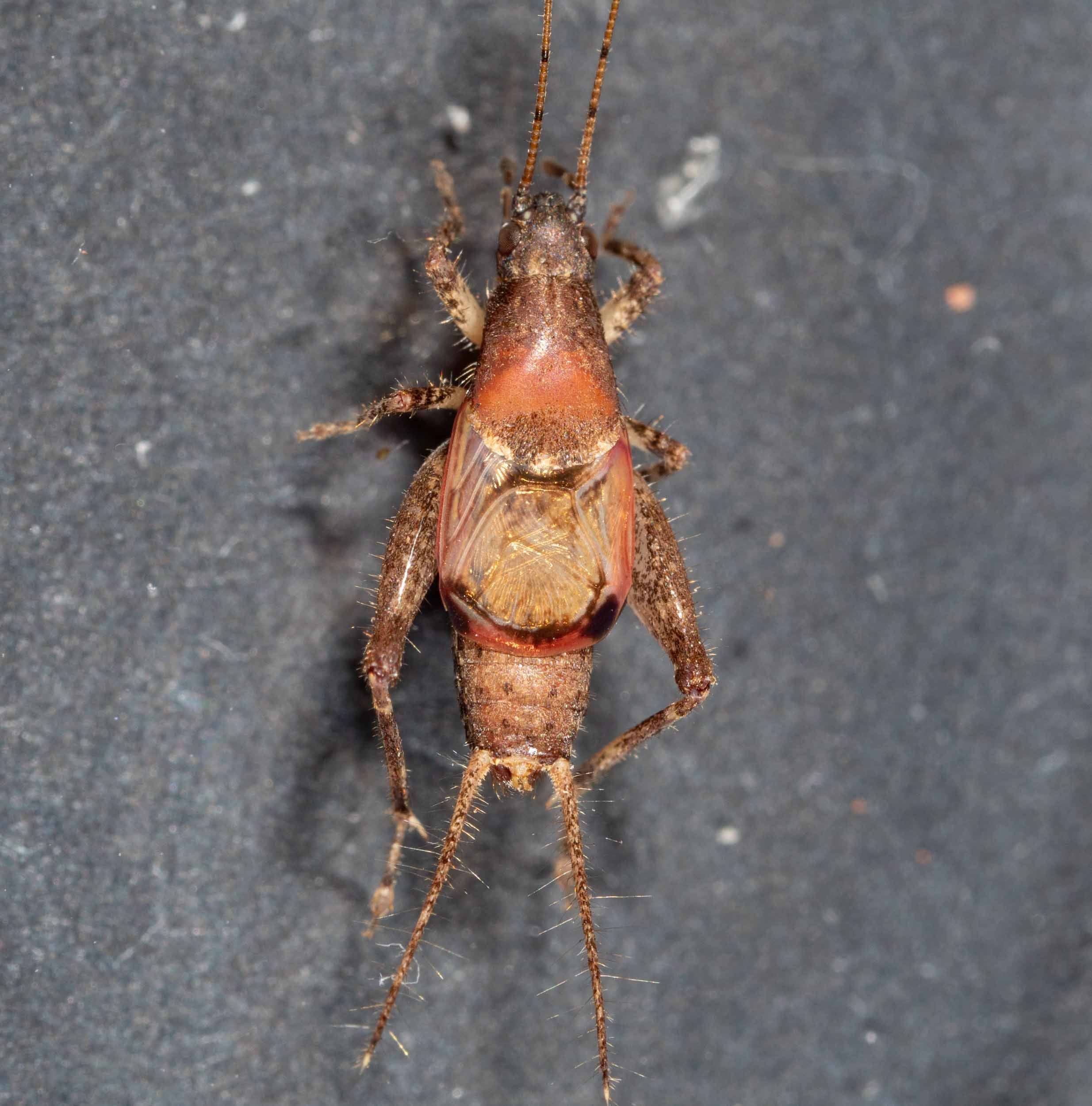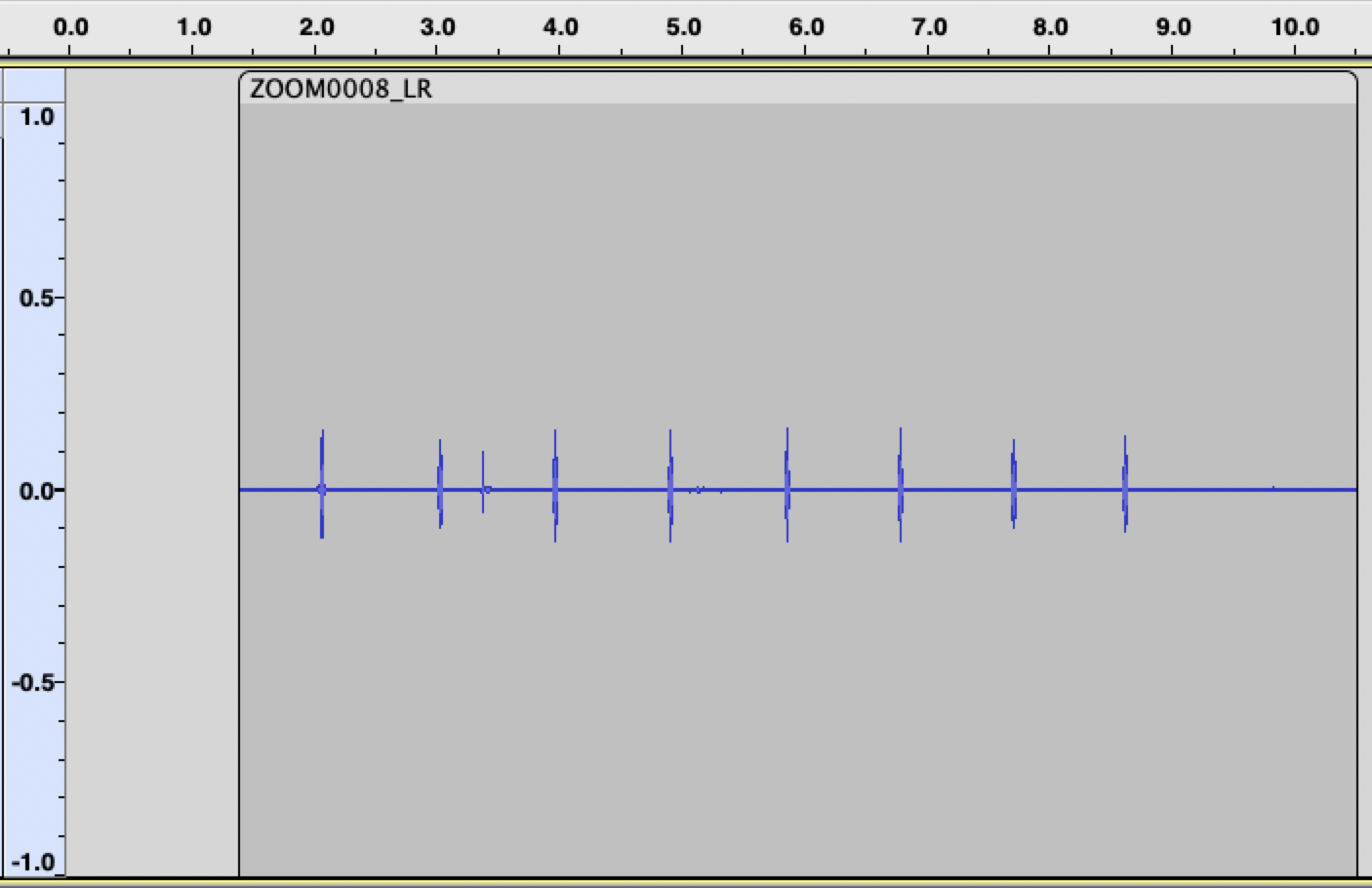New Ornebius sp.

Workbook
On 11th February 2015 I found a cricket under the mat on the front deck, which I identified as an Ornebius sp. - subsequently confirmed by Bob Love, a retired Californian natural sciences museum curator (iNaturalist observation here). This first specimen was a male nymph. Short forewings, just extending beneath pronotum. Body length 8mm.
I subsequently discovered a very similar male nymph in our February 2020 malaise trap collection (iNaturalist observation here) - also confirmed as an Ornebius sp. by Bob Love.
On 5th May, 2018 we sighted a female on the bedroom window. While we only have this one out of focus photo, the cricket appears to be an Ornebius sp. and looks similar to the other Ornebius specimens we have found here.
On October 4th, 2023, Kerri found this female cricket in the wheel-barrow with sawn wood. She appears to be very similar to the preceding female.
On 7th July 2023, Kerri found a cricket amongst branches sawn from a fallen eucalypt near the eastern boundary of the block. These branches had been lying on the ground for over a week before she gathered them, so the cricket had probably been living in the undergrowth nearby.
This individual, an adult male, looks very similar to these previous Ornebius crickets.
Habitus images of the living cricket
I used Otte and Alexander 1983 to identify this cricket.
Genus Ornebius
- body length > 7.5mm (8.5mm)
- last dorsal segment of abdoment not black between cerci
- genital processes brown to pale brown or whitish (pale brown)
- posterior margin of forewings with continuous brown or black band (not red) or with 3 darkened areas (black lateral markings)
- tibiae I and II slightly or strongly banded (strongly banded)
- front of mirror not hidden beneath pronotum
These features are evident in the habitus images above.
Notes in Otte and Alexander place the cricket in Illaroo species group
- legs I and II strongly banded
- face usually with contrasting markings (frons and clypeus black, vertex mottled dark brown)
- 10th tergite of abdomen usually with two tufts of setae near centre (a continuous line of setae across posterior margin of tergite)
- forewings often with 3 dark marks along posterior margin and indistinct dark markings scattered over remainder (dark marks in posterior corners and on medial region of mirror at its anterior and posterior margins)
These features are evident in the images below.
Key in Otte and Alexander for Illaroo group males
1. FWs with dark marks near posterior margin, but otherwise light brown or transparent (YES)
2. Exposed FW length distinctly shorter than exposed abdomen length (75% of abdomen length, but how much of abdomen is “exposed”?). Rostral width (defined as “narrowest width beyond where sides of rostrum cease converging”) at least 2x width of antennal scape (1.3-1.5x width of antennal scape).–>3
vs. Exposed FW length nearly as long as exposed abdomen length. Rostral width less than 1.9x width of antennal scape. –> 6
3. Body colour brown to light brown. Head and pronotum without dense covering of scales (scattered distribution of scales over vertex) –> 4.
vs. Body colour dark brown. Head and pronotum with dense covering of dark scales. File with c. 137 teeth. –> antakira. (locality SE South Australia).
4. Pronotum not distinctly darker along dorso-lateral margins. Cerci at least as long as femur III (1.25x length of femur).
11. Maxillary palpi dark brown. FW marked as in Fig. 316A
–> jatalinga
1. FWs with dark marks near posterior margin, but otherwise light brown or transparent (YES)
2. Exposed FW length nearly as long as exposed abdomen length. Rostral width less than 1.9x width of antennal scape. –> 6
6. 10th tergite of abdomen without two tufts of setae near centre (continuous row of setae on 10th tergite rather than two tufts). Length of 5th segment of maxillary palp at least 2x its width (2.0x). –> 7.
7. Distal dark band on tibiae I and II clearly darker than proximal dark band (YES). File with ca. 185 teeth. –> 9.
9. Face, rostrum and antennal scape dark brown
–> kapunda
Description of O. jatalinga in Otte and Alexander:
Head and pronotum reddish brown; abdomen darker than pronotum - NO ; tibiae distinctly banded YES. Head brownish with very dark brown scales behind eyes YES?. Maxillary palpi brown YES. Pronotum reddish brown YES; lateral edge of disk with band of dark scales NO. Juncture of disk and lateral lobes pale NO; lateral lobes with band of dark scales NO. FWs short, front of mirror hidden beneath pronotum NO; posterior margin mostly dark, but dark band contains several light spots NO; lateral field dark ventrally NO. File with 74 teeth; 47.7mm at centre??. Femora I and II with pale background and with dark scales; scales not arranged in bands YES. Tibiae I and II distinctly banded YES; distal band much darker than central and proximal ones YES. Tibia III with 3 bands, distal band darkest NO - 2 bands. Dorsum of abdomen brown, darker than pronotum and FSs NO. Last few segments before cerci quite dark NO. Tenth tergite dark except for posterior margin which has two lateral processes (one next to inner base of each cercus) and two spine-like central processes separated by about 3/4 of their length PERHAPS. Genital processes light brown YES; base nearly black PERHAPS.
Body length/width 3.00-3.22 (3.7), pronotum length/forewing length 1.47-2.00 (0.78), head width/rostrum width 2.77-2.70 (0.78), rostrum width/rostrum length 2.00-2.25 (0.9?), rostrum width/scape width 2.0/2.07 (2.72), forewing length/forewing width 0.63-0.60 (1.18), mirror length/mirror width 0.85-0.92, body length 7.5-7.9 (8.5), femur III length 4.2-4.0 (4.0).
Markings on forewing don’t match figure of this species in Otte and Alexander
Nor does banding on tibia I or femur I
Also type locality is mountains in southeastern QLD.
Holotype ANIC A-517
Description of O. kapunda in Otte and Alexander:
Body reddish brown with dark brown face YES ; Abdomen darker than pronotum NO. Rostrum, face and scape dark brown, much darker than area behind rostrum YES. Frons with inverted Y-shaped light area ventrally ??. Side of head with dark brown scales behind eyes YES. Maxillary palpi: each segment with brown strip on outer face NO; 5th segment lighter centrally, darkest proximally and distally NO. Pronotal disk reddish YES; darkest along anterior margin behind eyes YES. Posterior margin of forewing with 3 main dark areas, posterior lateral corner darkest; these dark marks extend from edge about halfway to posterior mirror vein. YES?. Anterior lateral mirror vein dark where it joins diagonal vein YES. Lateral field mostly dark brown NO. File with 185 teeth. Femora I and II largely covered with dark scales on outer faces YES. Tibiae I and II distincly banded, distal band distinctly darker than proximal band YES. Distal dark band interrupted on top by light gap YES; 3rd segment with small dark area at proximal end, pale centrally, dark in distal half ??. Femur III covered with brown scales which are not as dark as those of femora I and II YES. Tibia III banded, distal band darkest YES? Dorsum of abdomen darker than pronotum, becoming dark brown distally NO, each tergite with dark lateral margin NO. 10th tergite largely pale, much lighter than preceding tergites and without central groups of setae. NO (extreme end is lighter but continuous row of setae present). Sternum dark, becoming very dark on subgenital plate YES. Genital processes very slender, cylindrical, pale.
Markings on forewing in Otte and Alexander
Range southcentral to southern coastal QLD. Holotype from Rockhampton. Habitat forest undergrowth and forest margin.
Holotype ANIC A-298
drawing of subgenital plate from O&A doesn’t match but genital process is close.
Conclusion: Neither of these Illaroo group species is a perfect match to my adult male and none of the other species in that group appears to be a better match. This suggests that my specimen may be an undescribed species.
You Ning Su has replied to my query on 11th July to confirm that “this is one of the undescribed species in South East NSW”.
We have heard this individual calling on several occasions and finally managed to make a recording of his call on 21st July at around 9:30pm. This recording reproduces a sequence of 3 chirps.
I have edited this recording, splitting it into the 3 separate chirps. The first has 6 pulses about one pulse per second.
The second chirp started 9 seconds later and consists of 12 pulses about one pulse per second.
The third chirp started 20 seconds later and consists of 9 pulses about one pulse per second.
I used Audacity software to create an audiogram of this sequence of calls.
The 3 chirps
The first chirp
second pulse in the first chirp
second pulse in the first chirp
Detail of middle region of second pulse.
Frequency analysis of a pulse. Carrier frequency = 5 KHz
Calling heard again late in evening on 22nd July
First song 9:26pm - 3 chirps, first with 7 pulses, second 7.5 seconds later with 7 pulses, third 17 seconds after that with 7 pulses. In each case, pulses are separated by 1 second.
first song with 3 chirps - spectrogram shown below audiogram with major frequency at 5kHz
second chirp 10:29pm - 4 pulses separated by 1 sec.
chirp 02
third chirp 10:29:30pm - 7 pulses separated by 1 sec
fourth chirp 10:30pm - 7 pulses separated by 1 sec
chirp 04 - spectrogram shown below audiogram with major frequency at 5kHz
fifth chirp 10:54pm - a chirp with 8 pulses, separated by 0.93 sec.
chirp 05
sixth chirp 10:56pm - 8 pulses separated by 1.05 sec
chirp 06
26th July
Kerri heard the cricket calling at 9:00pm - a couple of pulses separated by a second before it stopped. She didn’t manage to get a recording.
Conclusions to date:
Cricket appears to only call in the late evening - after 9:00pm. Kerri hasn’t heard him calling at other times of the day.
Calls generally comprise single chirps, each consisting of 4-12 pulses (mean 7.4, SD 1.9, n=11) separated by 1 second. In two cases, there were 3 chirps in a call, separated by 7 to 17 seconds
Chirps are separated by time intervals of between 6 and 23 seconds. Calls were separated by time intervals of between 30 seconds and 1 hour.
27th July
Euthenased the cricket. Photographed various structures.
Dissected out the upper tegmen, photographed its underside and the upperside of the lower tegmen on the cricket.
Counted the teeth on the stridulatory vein of the upper tegmen - 182+/-2 teeth and 116 teeth/mm. This vein is raised and the row of teeth constitutes the file of the sound production apparatus.
Other genera in this subfamily have file teeth numbers ranging from 51-341 (341, 165, 210, 221, 143, 166, 249, 51, 78). There is no relationship between no. file teeth and frequency of call.
Stridulatory vein on upper tegmen showing ~180 teeth.
View of lower tegmen after removal of upper tegmen. The region of the wing edge indicated by an arrow acts as a scraper, rubbing over the file as the wings are closed producing vibrations of the wing which constitute a single sound pulse.
Upperside of lower tegmen also has a row of teeth in a recessed vein, but these are not as well developed as on the upper tegmen and are presumably vestigial structures.
Close examination of the region at the edge of the stridulatory vein reveals cuticular ridges which presumably act as the scraper which produces the calling sound when it rubs over the ridges in the stridulatory vein in the upper wing.
This is a workbook page … a part of our website where we record the observations and references used in making species identifications. The notes will not necessarily be complete. They are a record for our own use, but we are happy to share this information with others.






























































